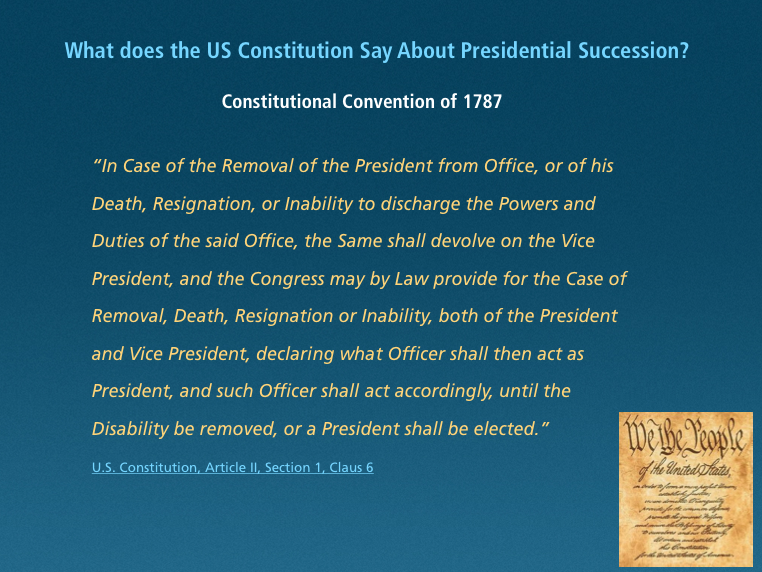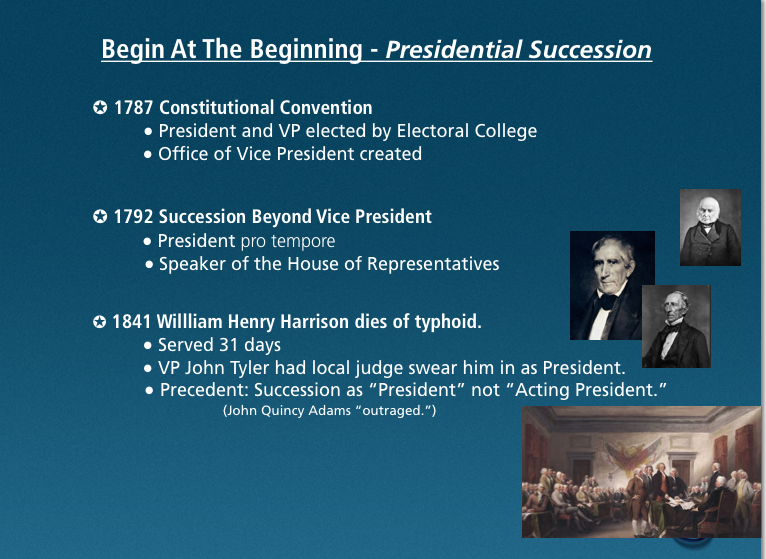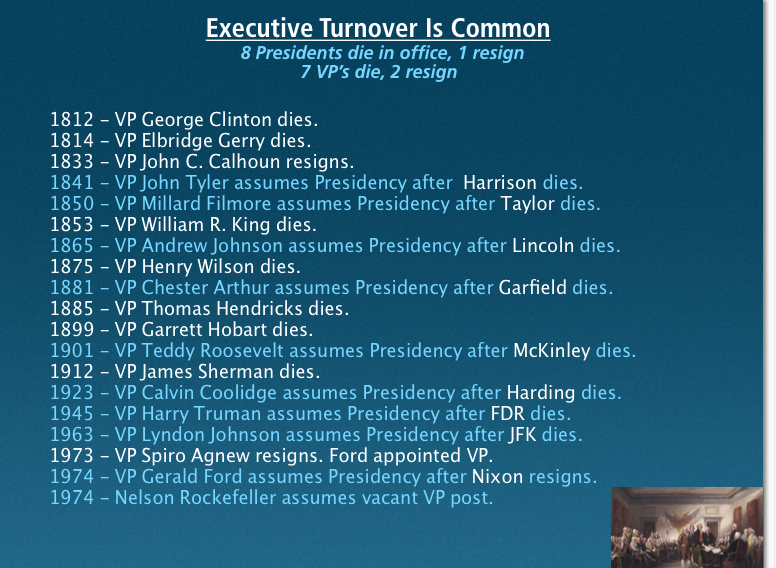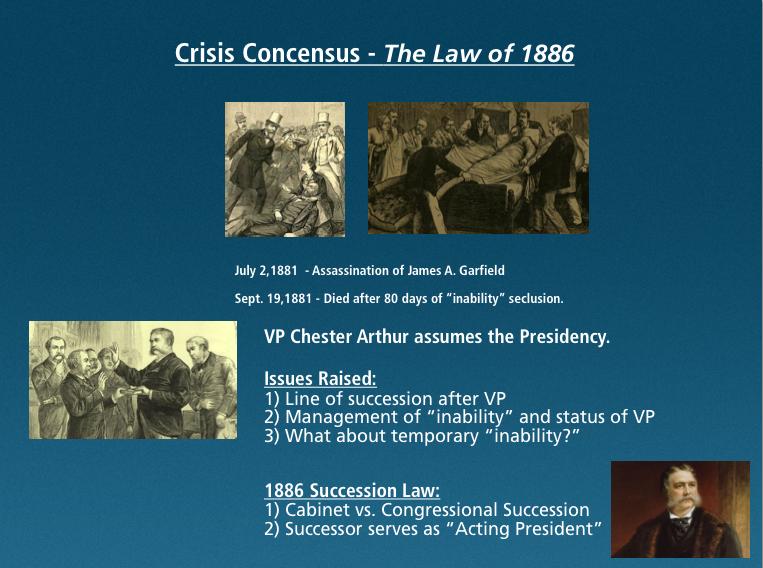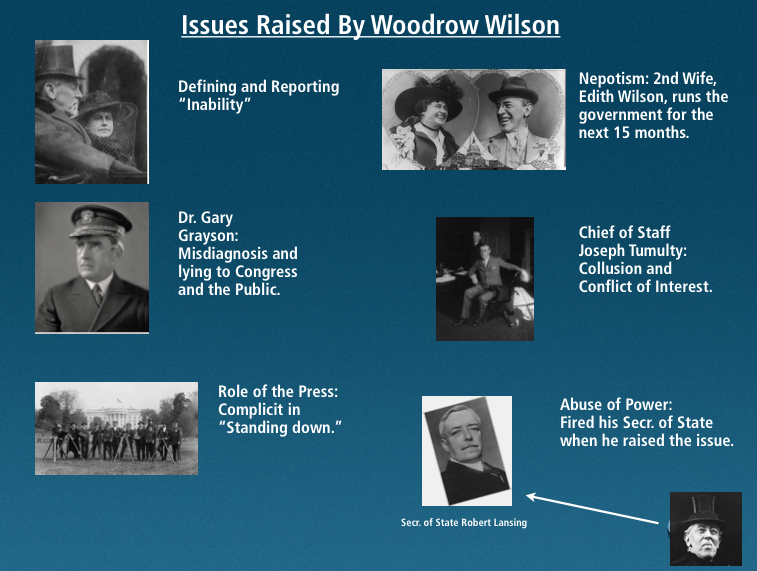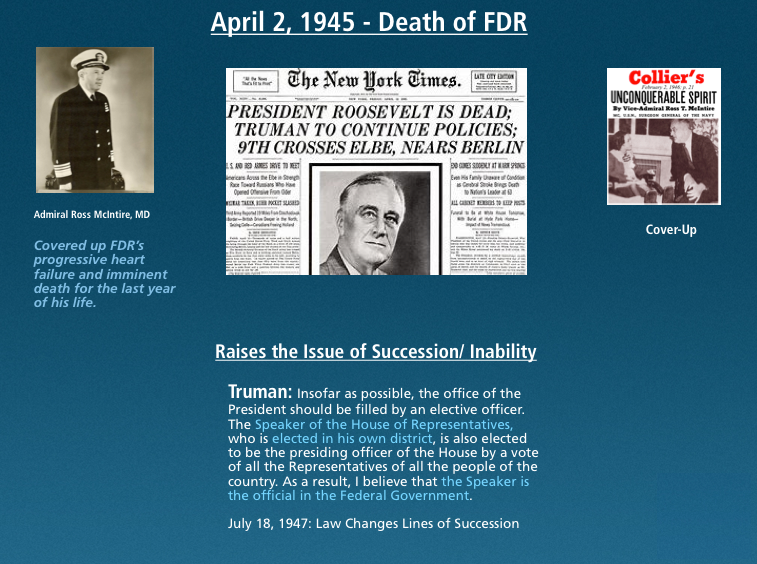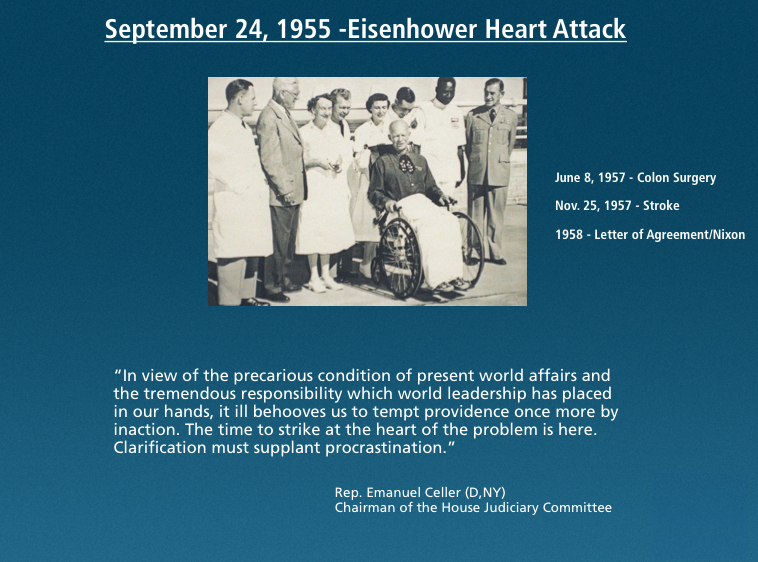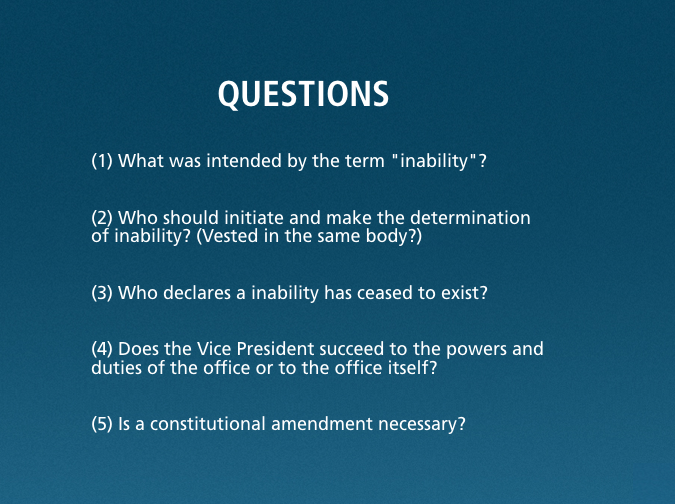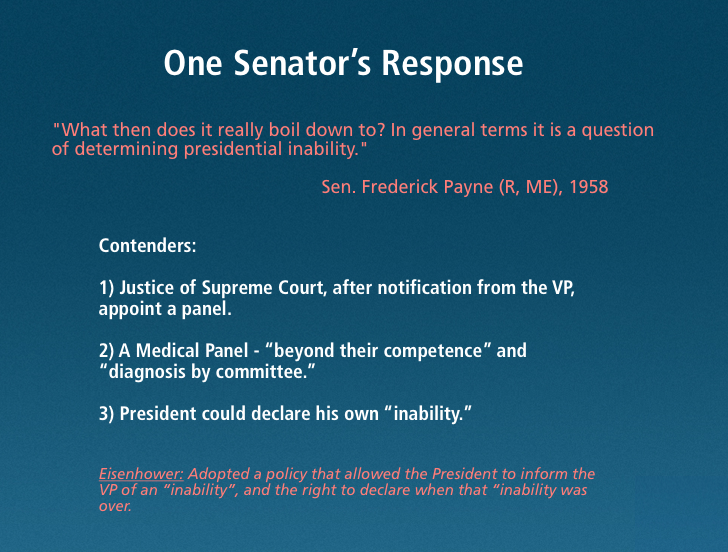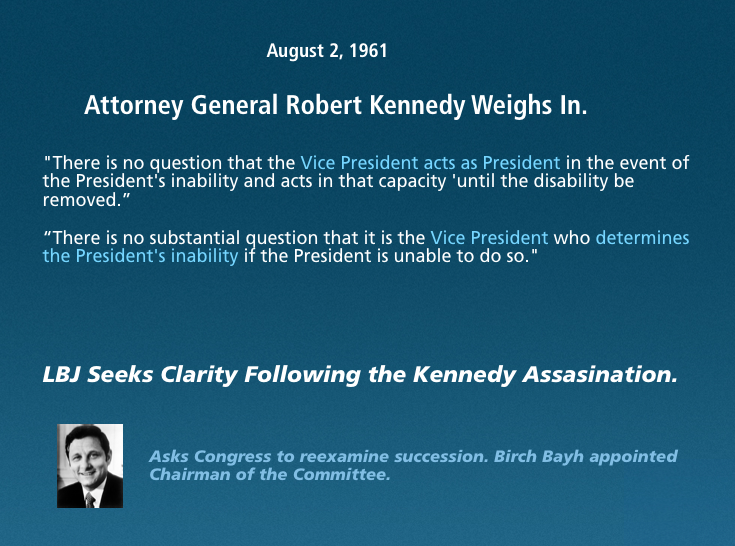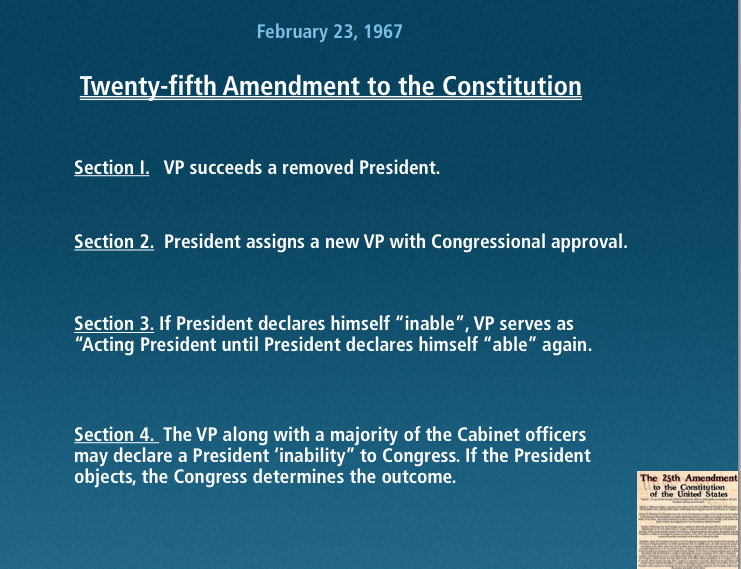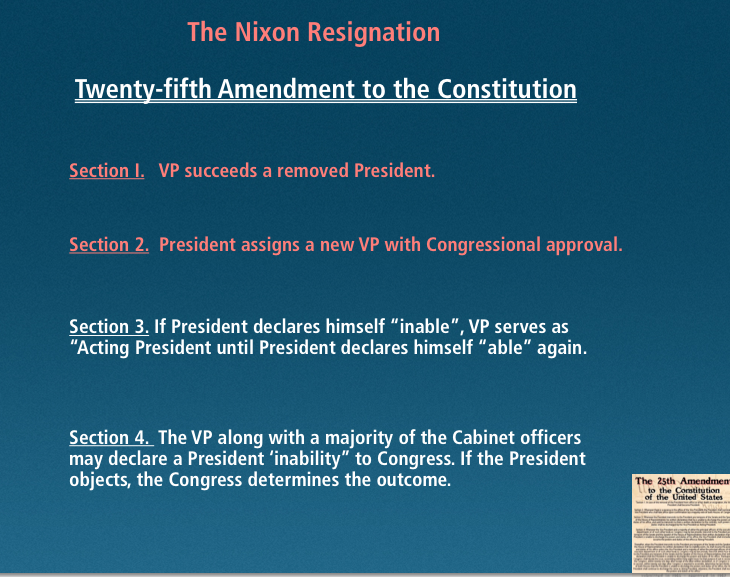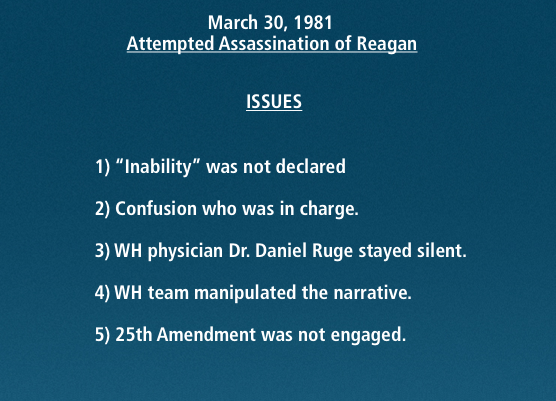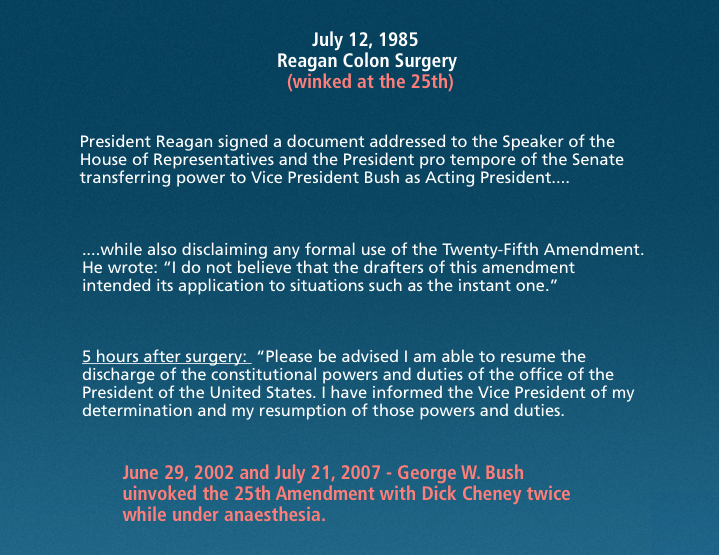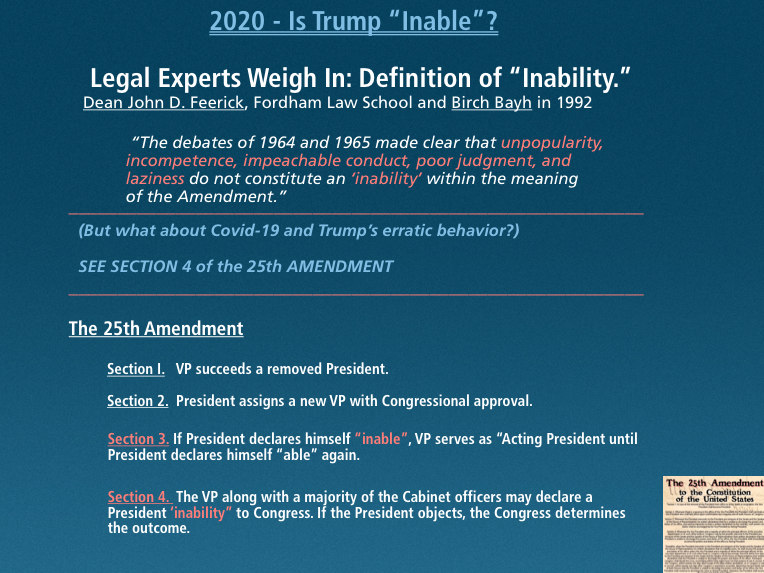The History of Presidential Health, Succession, and the 25th Amendment in 15 slides.
Posted on | October 5, 2020 | Comments Off on The History of Presidential Health, Succession, and the 25th Amendment in 15 slides.
Mike Magee
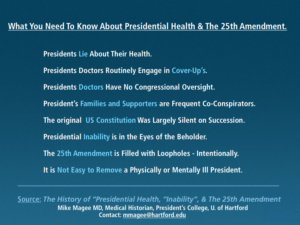
In 2019 I taught a course at the President’s College at the University of Hartford titled “The President’s Health and the 25th Amendment.” The questions raised then are now prescient and include:
1. What is the 25th Amendment?
2. How do you define “inability” and who defines it?
3. Has Presidential “inability” been a problem in the past?
4. What is the role of the White House physician?
5. What is his/her responsibility to the nation?
6. Is a Presidential candidate required to release medical records?
7. Have White House doctors lied to the public in the past?
8. Have Presidents lied about their health?
In this abbreviated format, here are 15 selected slides from that course with brief commentary.
Slide 1. The first commentary in our Constitution did not appear until 1787. This was not simply an oversight on the part of our Founding Fathers. Rather it reflected that the issue would be thorny and complicated – as it has remained to this day. In the statement, the position of Vice President is established, and (in the case of inability of the President) his duties “devolve on the Vice President” until the Congress identifies who should take the President’s place.
Slide 2. Over the next roughly half century, the issue of succession surfaces twice. In 1792, five years after the Constitutional Convention, Congress establishes that the line of succession after the Vice-President will be first to the leader of the Senate and then to the leader of the House of Representatives. When President William Henry Harrison dies in office from Typhus 49 years later, his Vice President, John Tyler”, has a local judge swear him in as “President.” John Quincy Adams is outraged by this precedent setting move since most believed he was only entitled to serve for an interim period as “Acting President.”
Slide 3. Historically, turnover in the Executive Office has been relatively common in our history requiring frequent succession. Violence and disease have been the common instigators of these crises.
Slide 4. Formal discussions regarding how best to legislatively manage succession have often followed these acute crises. On July 2, 1881, James Garfield was shot. Though incapacitated, he (and his supporters) refused to relinquish control of the government for the next 80 days until he died. When Chester Arthur, his VP assumed the Presidency, he directed the Legislature to reconsider the issue of succession. In 1886, they passed the Succession Act. It created a line of successors in the Cabinet should a President and Vice President become disabled. The successor would be titled “Acting President.” The issue of defining “inability” and who could determine “inability” was left unaddressed.
Slide 5. President Woodrow Wilson is often cited as the prime example of Presidential abuse when faced with incapacity. During his second term, exhausted from campaign efforts in support of passage of the League of Nations, Wilson suffered a stroke on October 2, 1919. For the next 15 months, Wilson’s 2nd wife, Edith Wilson, his long time Chief of Staff, Joe Tumulty, and White House Dr. Gary Grayson entered into a conspiracy to run the government and cover up his incapacity. The VP would not confront the issue fearing he’d be accused of opportunism. When the Secretary of State, Robert Lansing, finally surfaced the problem, he was fired. Wilson had to be convinced not to run for a 3rd term. He died on March 4, 1921.
Slide 6. White House doctors through history have routinely lied about the President’s health. Wilson’s doctor was not an outlier. FDR’s doctor, Admiral Ross McIntire, actively hid FDR’s progressive and eventually fatal Congestive Heart Failure for over a year before he died in office. This included penning a rosy portrayal of the President’s health in Collier’s magazine, titled, “Unconquerable Spirit” 2 months before he died.
Slide 7. In the middle of the Cold War, on September 24, 1955, President Eisenhower suffered a massive heart attack that confined him for months out West until he could be transported back to his home in Gettysburg, PA. He reportedly insisted on waiting until he was capable of walking unaided up the airplane stairs for a photo op. The Democratic Congress at the time asked for hearings to clarify succession issues. In 1958, rather than submit to legislative changes, Eisenhower penned a letter to Nixon, authorizing a temporary and reversible transfer of power were he to declare “inability” to govern.
Slide 8. At the time, Congress raised, and Eisenhower partly addressed the issue in his letter to Nixon.
Slide 9. Senator Frederick Payne (R, ME) had this response in 1958. The key issue he said was “Who will determine ‘inability’?”
Slide 10. Attorney General Robert F. Kennedy commented directly on the role of the Vice-President in declaring “inability” if a President is unable to do so himself. After JFK is assassinated, LBJ seeks clarity on the issue of succession. A junior senator from Indiana agrees to head up a Congressional committee to explore the need for a Constitutional Amendment. Few believe it will amount to much.
Slide 11. Since 1788, there have been 11,000 proposed Amendments to the Constitution. Only 27 to date have succeeded and 10 of these were contained in the original Bill of Rights. Ratification of an Amendment requires support from 2/3 of both Houses of Congress, and approval by ¾’s of the states. On January 23, 1967, the 25th Amendment was ratified.
Slide 12. During Nixon’s second term, the 25th Amendment gets a work out. VP Spiro Agnew resigns in disgrace. Gerald Ford is appointed by President Nixon. Nixon resigns and Ford assumes the Presidency. Ford appoints Rockefeller as his VP.
Slide 13. During his Presidency, Ronald Reagan ignores the 25th Amendment after an assassination attempt. His PR people create an inaccurate and deceptive heroic narrative for public consumption to cover-up the seriousness of his condition. Returning a “hero” to address both Houses of Congress helps Reagan pass his “trickle down” tax cut which is partially reversed one year later.
Slide 14. When Reagan undergoes general surgery for colon cancer, he transfers power temporarily to George H. W. Bush, but specifically notes that he is not invoking the 25th Amendment. Late in his second term, the First Lady, and White House staff (including the White House doctors) cover-up Reagan’s declining mental status. George H. Bush is the first to formally invoke the 25th Amendment when under anaesthesia to Dick Cheney.
Slide 15. In 1992, twenty-five years after its passage, Birch Bayh and Fordham University Dean of the Law School, John D. Feerick (both of whom were involved in creating the original language for the 25th Amendment in 1967), co-chair a committee to re-examine the Amendment, and recommend any necessary changes. They conclude it should be left as is, deciding that the issue of both “inability” and “transfer of power” is primarily a political decision, and that transferring the power to override the result’s of the body politics vote to a medical committee, the Supreme Court, or other expert body, would create more problems than it would solve. They also reinforced their faith in Section 4 of the 25th Amendment – a succession scheme empowering the Cabinet and the Vice-President to appeal to Congress to remove an “inable” President who refuses to leave.
